Stink Bugs: Besides the Brown Marmorated One
By Pat Dickey, Fairfax Master Gardener
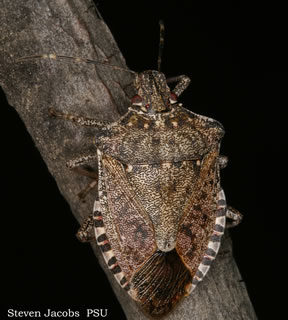
Brown marmorated stink-bug
The Brown Marmorated Stink Bug (Halyomorpha halys) was brought to the United States around 1996 in shipments from China, Japan, Korea and Taiwan, where it is a native agricultural pest. As of 2014, these bugs have been seen in 41 states in single sightings or in reproducing populations. They are true bugs from the family Pentatomidae and are phytophagus or plant-eating bugs.
Measuring 0.5 x 0.625 inches, the BMSB has a shield-shaped, marbled (marmorated) brown abdomen and marbled legs. There are also two lighter white bands on the antennae and darker bands on the overlapping part at the rear of the front pair of wings. Patches of coppery or bluish metallic-colored punctures or depressions are on the head and pronotum near the head. These characteristics distinguish them from the other stink bugs in Virginia.
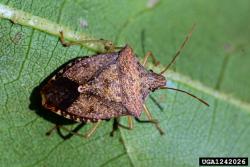 Brown Stink Bug |
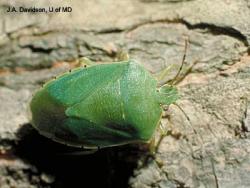 Green Stink Bug |
Yes, there are other important native pest stink bugs in our state, the brown stink bug (Euschistus servus) the green stink bug (Acrosternum hilare), and the harlequin bug (Murgantia histrionica). All of them also have a five-sided shield shape, and are similar in size to the BMSB. The brown stink bug has grayish brown on top and a yellowish coloring on its lower abdominal surface, and the green stink bug has an overall green appearance. The harlequin bug has bright yellow/orange and black coloring. All three stink bugs emit a foul odor as a defense mechanism. The BMSB has a distinct odor much like cilantro.
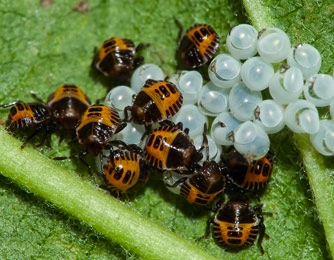
BMSB nymphs 1st instar
Stink bugs damage many host plants, including tomato, pepper, bean, okra, pecan, lettuce, sweet corn, soybeans, cucumbers, squash and many fruit crops, such as apples, peaches and berries. Harlequin bugs favor the brassica family–cauliflower, broccoli and cabbage—and leaf crops such as kale and spinach. White marks called halos appear on tomatoes and peppers, making them unmarketable. The damage on beans and okra is a wart-like growth or pimple. Stink bugs can damage tree fruit by cat facing the surfaces, that is, scarring and dimpling the fruit with their mouthparts.
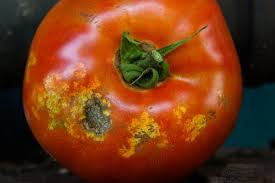
Stink bug damage on tomato
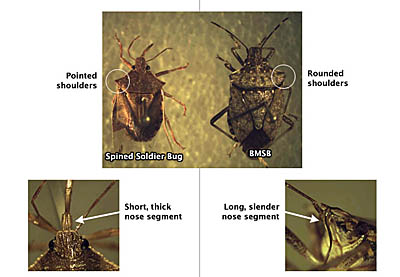 To help control pest stink bugs, remove weeds and wild fruit trees to keep the bugs from sheltering there and damaging your crops. Keep grass trimmed and remove piles of clippings. Parasitic wasps help keep down populations of the pest stink bugs in the egg stage so that the number of nymphs are decreased. They are slowly beginning to parasitize the Brown Marmorated Stink Bug eggs as well as those of the native stink bugs. That is good news! Botanical insecticide dusts may help to control stink bugs. Organic insecticides are also available for the home garden, such as pyrethrins and insecticidal soap. It is important to read the label and follow all precautions.
To help control pest stink bugs, remove weeds and wild fruit trees to keep the bugs from sheltering there and damaging your crops. Keep grass trimmed and remove piles of clippings. Parasitic wasps help keep down populations of the pest stink bugs in the egg stage so that the number of nymphs are decreased. They are slowly beginning to parasitize the Brown Marmorated Stink Bug eggs as well as those of the native stink bugs. That is good news! Botanical insecticide dusts may help to control stink bugs. Organic insecticides are also available for the home garden, such as pyrethrins and insecticidal soap. It is important to read the label and follow all precautions.
A little-known fact — Some stink bugs are actually beneficial bugs. Gardeners should learn to recognize the differences between the pest stink bugs and the predacious or beneficial ones. The spined soldier bug (Podisus maculiventris) prefers to feed on Colorado potato beetles, Mexican bean beetles, and various caterpillar larvae, but preys on close to 200 species of immature insects. It looks a lot like the Brown Marmorated Stink Bug. It also has the five-sided shield shape, and its abdomen is light brown to tan, with pointed shoulders. There is a distinctive dark line on the tip of each forewing that forms one dark streak when the wing tips overlap. Another difference between the pest stink bugs and the beneficial stink bugs is the size of the proboscis. On the predatory spotted stink bug, the proboscis is twice the width of the antennae, allowing it to kill its prey. The BMSB has a narrower proboscis with a width similar to the width of the antennae.
References
Stink Bugs, VCE Publication, Eric Day, Dept of Entomology
Field Guide to Stink Bugs of Agricultural Importance in the U.S., VA Tech Regional IPM Center
“Finally, some good news about stink bugs,”,Michelle Basch, WTOP News, May 26, 2016
“Stink Bug Prevention: 10 Tips to Keep This Smelly Pest at Bay” National Pest Management Assn.
Pest Management Guide: Home Grounds and Animals, Home Vegetables, Virginia Cooperative Extension
Brown Marmorated Stink Bug, Penn State Extension